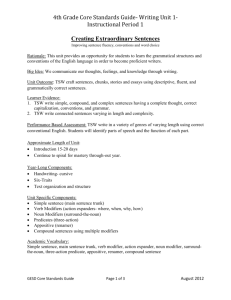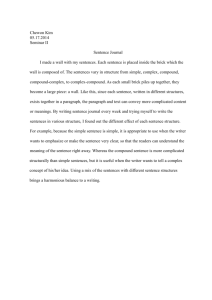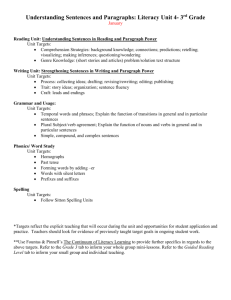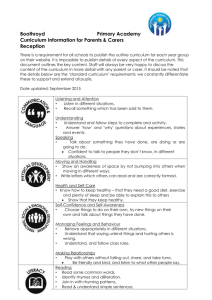3.W.01 Sentence Construction
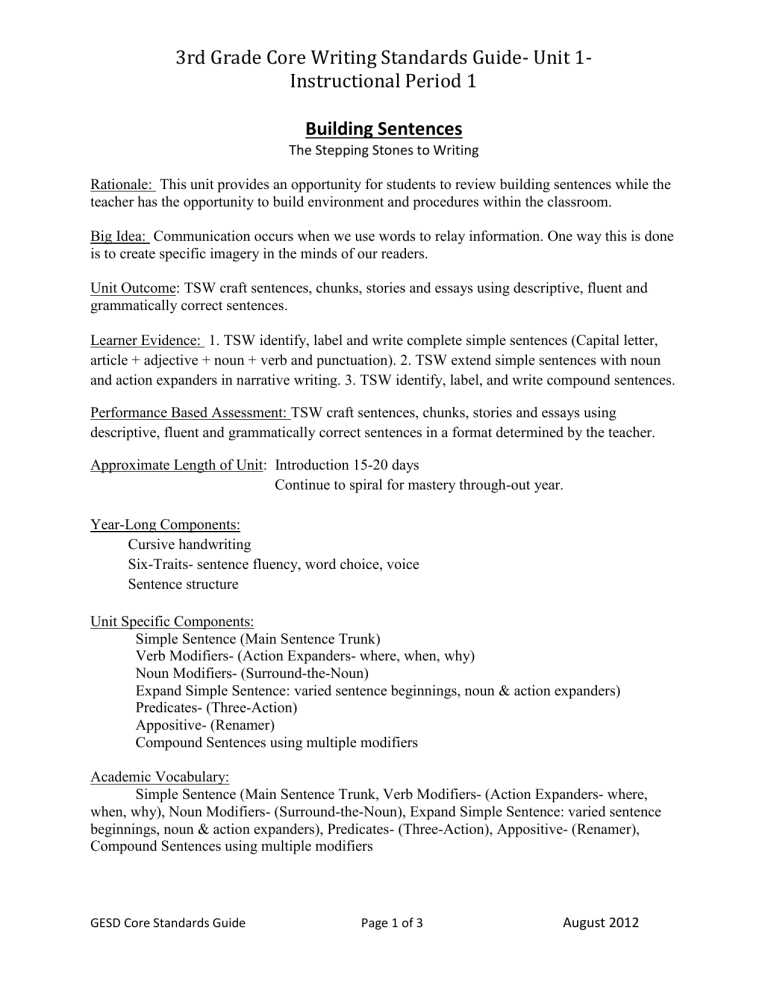
3rd Grade Core Writing Standards Guide- Unit 1-
Instructional Period 1
Building Sentences
The Stepping Stones to Writing
Rationale: This unit provides an opportunity for students to review building sentences while the teacher has the opportunity to build environment and procedures within the classroom.
Big Idea: Communication occurs when we use words to relay information. One way this is done is to create specific imagery in the minds of our readers.
Unit Outcome: TSW craft sentences, chunks, stories and essays using descriptive, fluent and grammatically correct sentences.
Learner Evidence: 1. TSW identify, label and write complete simple sentences (Capital letter, article + adjective + noun + verb and punctuation). 2. TSW extend simple sentences with noun and action expanders in narrative writing. 3. TSW identify, label, and write compound sentences.
Performance Based Assessment: TSW craft sentences, chunks, stories and essays using descriptive, fluent and grammatically correct sentences in a format determined by the teacher.
Approximate Length of Unit: Introduction 15-20 days
Continue to spiral for mastery through-out year.
Year-Long Components:
Cursive handwriting
Six-Traits- sentence fluency, word choice, voice
Sentence structure
Unit Specific Components:
Simple Sentence (Main Sentence Trunk)
Verb Modifiers- (Action Expanders- where, when, why)
Noun Modifiers- (Surround-the-Noun)
Expand Simple Sentence: varied sentence beginnings, noun & action expanders)
Predicates- (Three-Action)
Appositive- (Renamer)
Compound Sentences using multiple modifiers
Academic Vocabulary:
Simple Sentence (Main Sentence Trunk, Verb Modifiers- (Action Expanders- where, when, why), Noun Modifiers- (Surround-the-Noun), Expand Simple Sentence: varied sentence beginnings, noun & action expanders), Predicates- (Three-Action), Appositive- (Renamer),
Compound Sentences using multiple modifiers
GESD Core Standards Guide Page 1 of 3 August 2012
3rd Grade Core Writing Standards Guide- Unit 1-
Instructional Period 1
Common Core Standards:
3.W.10. Write routinely over extended time frames (time for research, reflection, and revision) and shorter time frames (a single sitting or a day to two) for a range of discipline-specific tasks, purposes, and audiences.
3.L.2. Demonstrate command of the conventions of standard English capitalization, punctuation, and spelling when writing. a.
Capitalize appropriate words in titles. b.
Use commas in addresses c.
Use commas and quotation marks in dialogue. d.
Form and use possessives. e.
Use conventional spelling for high-frequency and other studied words and for adding suffixes to base words (e.g., sitting, smiled, cries, happiness). f.
Use spelling patterns and generalizations (e.g., word families, position-based spellings, syllable patterns, ending rules, meaningful word parts) in writing words. g.
Consult reference materials, including beginning dictionaries, as needed to check and correct spelling.
3.L.1. Demonstrate command of the conventions of standard English grammar and usage when writing or speaking. a.
Explain the function of nouns, pronouns, verbs, adjectives, and adverbs in general and their functions in particular sentences. b.
Form and use regular and irregular plural nouns. c.
Use abstract nouns (e.g., childhood). d.
Form and use regular and irregular verbs. e.
Form and use the simple (e.g., I walked; I walk; I will walk) verb tenses. f.
Ensure subject-verb and pronoun-antecedent agreement. g.
Form and use comparative and superlative adjectives and adverbs, and choose between them depending on what is to be modified. h.
Use coordinating and subordinating conjunctions. i.
Produce simple, compound, and complex sentences.
3.L.3 Use knowledge of language and its conventions when writing, speaking, reading, or listening. a. Choose words and phrases for effect. b. Recognize and observe differences between conventions of spoken and written standard
English.
3.L.5 Demonstrate understanding of word relationships and nuances in word meanings. b. Identify real-life connections between words and their use.
GESD Core Standards Guide Page 2 of 3 August 2012
3rd Grade Core Writing Standards Guide- Unit 1-
Instructional Period 1 c. Distinguish shades of meaning among related words that describe states of mind or degrees of certainty.
Arizona State Standards:
S1C3PO1 Evaluate the draft for use of voice, word choice, and sentence fluency.
S1C3PO2 Add details to the draft to more effectively accomplish the purpose.
S1C3PO3 Rearrange words, sentences, and paragraphs to clarify meaning of the draft.
S1C3PO4 Use a combination of sentence structures (simple, compound) to improve sentence fluency in the draft.
S1C3PO5 Modify word choice appropriate to the application in order to enhance the writing.
S1C3PO6 Apply appropriate tools or strategies (peer review, rubrics, checklists) to refine the draft.
S1C4PO1 Identify punctuation, spelling, and grammar and usage errors in the draft.
S1C3PO2 Convey a sense of originality, sincerity, liveliness, or humor appropriate to topic and type of writing.
S1C4PO1Use a variety of specific and accurate words that effectively convey the intended message.
S1C4PO2 Use descriptive words and phrases that energize the writing.
S1C5PO1 Write simple and compound sentences
S1C5PO2 Write sentences that flow together and sound natural when read aloud.
S1C5PO3 Vary sentence beginnings, lengths, and patterns to enhance the flow of the writing..
S1C6 Conventions
GESD Core Standards Guide Page 3 of 3 August 2012

